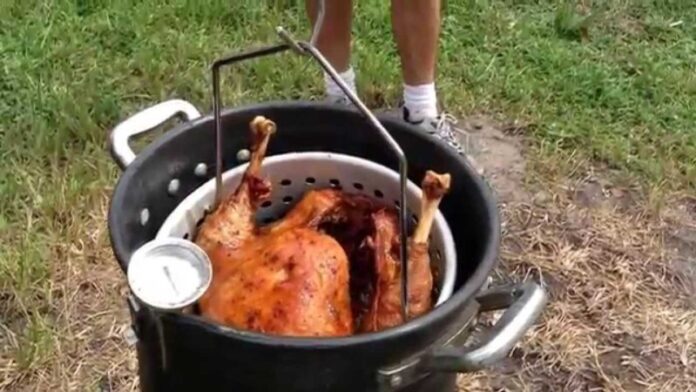So you want to fry a turkey? Well, here’s a start, never say “Hold my beer while I drop this turkey”. Most Thanksgiving accidents involve frying turkeys, and usually some form of alcohol. Turkey frying is also the reason most firefighters can’t finish their meal.
It’s simple folks, you are adding a bird with lots of moisture into a vat of 350* cooking oil. You should always use proper equipment and have safety gear nearby. More on that in a bit.
However, if you follow the safety guidelines and with a little effort, you can create a masterpiece that people will talk about for a long time.
Now let’s talk turkey frying:
-
- Buy a turkey deep fryer. We will not discuss any other piece of equipment. No contraptions made with grandma’s garbage can, Uncle Jimmy’s propane tank and duct tape. Spend some money. Maybe split the cost with neighbors. Remember you can use this in the spring and summer for fish frys and more.
- Ok, buy your turkey (do not unpackage) , and put it in the pot. fill your pot with water until submerged. this is your oil fill line. make a mark in approximation with a sharpie inside and outside the pot.
- Follow our thawing instructions. I prefer a dry brine for frying.
- Buy yourself an injector. You can buy any number of injections pre-made. I prefer to make my own of butter, garlic, and Tony Cacheres. You can also Google literally hundreds of injection recipes.
- Injections should be done at 6 hours before, preferably the night before. Hit the breasts and thighs heavy, and meaty parts of the wings and legs
- Let turkey air dry 20-30 minutes before inserting into oil.
- Don’t place the fryer in your garage, near overhangs, trees, wood patios, siding. Use common sense and look around. If it is raining, you are probably gonna have to go to a plan B. So, watch your forecast. Keep a bag of sand nearby for any small fire. Water and oil do not mix. A chemical fire extinguisher will work also.
- Buy enough oil to hit your fill line, if doing multiple turkeys, buy extra. You want a smoking point of 450*. I prefer peanut oil if no one has allergies.
- Place pot on heating element and fire it up per instructions. Start small and then build it up until your thermometer hits 325* – 350* (DO NOT REVERSE THESE 2 STEPS)
- Your turkey deep fryer comes with a turkey stand to insert into the body cavity of the turkey. Place the loop of the stand through the neck of the turkey and exit through the body cavity at the legs. Tie legs together with a piece of string.
- Once the oil has reached the correct temperature (350 degrees for turkeys that are 10 to 13 pounds, 325 for 14- to 20-pound turkeys) carefully lower the turkey into the boiling oil. Lower the turkey partially, then lift out, and repeat 3 or 4 times. This will help seal in the juices and keep the oil from boiling over. (This can be messy; oil can bubble out a bit. Wear gloves and try to stand back from the cooker.)
- Once the turkey has been submerged in the hot oil, cook for 3 to 3 1/2 minutes per pound. Fry turkeys that are 10 to 13 pounds for 3 minutes per pound, and for turkeys from 14 to 20 pounds, cook for 3 1/2 minutes per pound. A 10-pound turkey will take about 30 minutes. A 20-pound turkey will require about 1 hour, 10 minutes.
- Cook until the internal temperature reaches between 180 and 190 degrees Fahrenheit. Do NOT use the lid while frying.
- Once it reaches internal temp, TURN OFF THE HEATING ELEMENT. Wearing heavy gloves pull out your turkey slowly allowing the oil to drain into the pot. Place into whatever you are transporting it with and let it rest for 15-20 minutes before carving.
- DO NOT put lid on oil, it needs 3-4 hours to cool.
- Other than that enjoy your meal. Please be safe and fry responsibly.
Subscribe to our Newsletter!


































